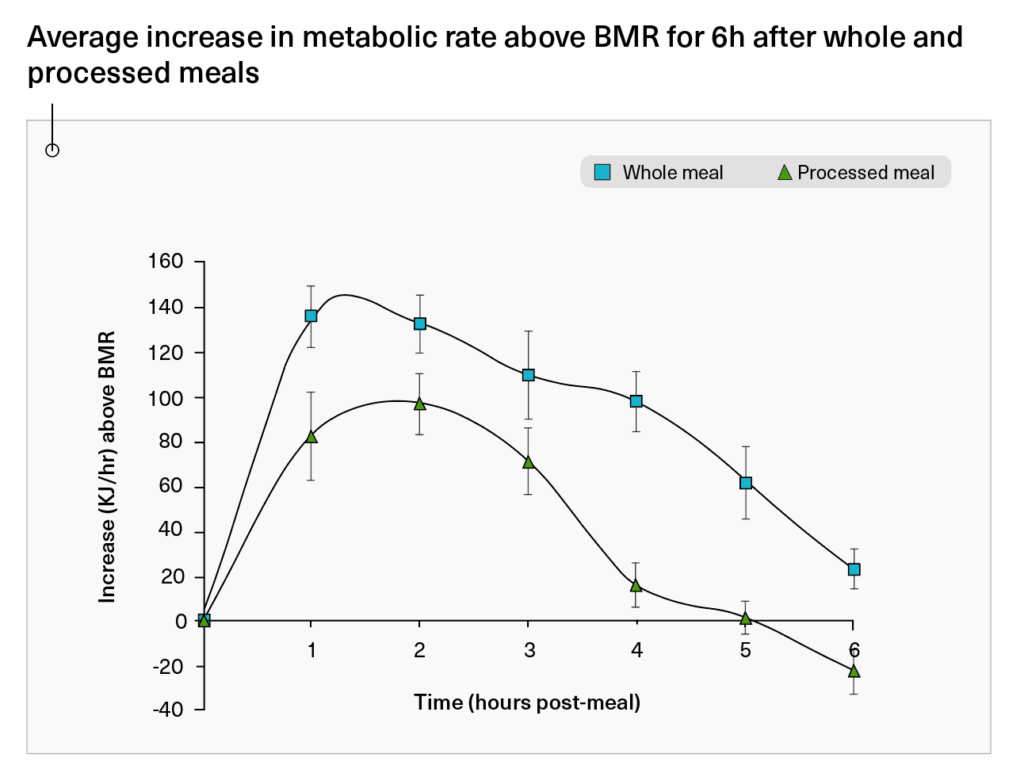TL;DR: A calorie is a calorie. But different foods affect your body differently because of: 1) the thermic effect of food, 2) calorie density, 3) satiety, and 4) palatability. The difference isn’t the calories, it’s how different foods are metabolised and the effects they have on behaviour. Let’s talk about that.
Contrary to what a bunch of shitbiscuits on the internet want you to believe, a calorie is a calorie.
Yes, that means exactly what you think it means: 100 calories in a chicken breast are exactly the same as 100 calories in a Snickers bar (the greatest chocolate ever created).
The difference ISN’T the calories – it’s the food composition and, specifically, how different foods are metabolised.
Confused? Don’t worry because we’re about to break this shit down.
A Calorie (capital C), also known as a kilocalorie (kcal), is simply a unit of energy. Just like kilograms are a unit of mass.
If Jack and Jill both weigh 70 kg, we can confidently say they weigh the same amount. It doesn’t matter if Jack has more muscle, is taller, and would rather throw himself down a hill than go to therapy––they both weigh 70 kg; ergo, they weigh the same.
Can we all agree on this? Good.
Well, the same is true for Calories.
When people say “a Calorie is a Calorie”, they’re highlighting how much energy a food provides our bodies, regardless of the source.
So, again, 100 Calories in a chicken breast are exactly the same as 100 Calories in a Snickers bar because…Yep! You guessed it, they both provide 100 Calories of energy to the body.
Now, remember earlier when I said, “The difference ISN’T the calories – it’s the food composition and, specifically, how different foods are metabolised”?
This is where the differences begin.
Thermic effect of food
The thermic effect of food is how much energy the body uses to digest and store the food you eat. Each macronutrient has a different thermic effect.
- Carbs: 5-10% (i.e. 5-10% of the calories are ‘lost’ to TEF)
- Protein: 20-30% (i.e. 20-30% of the calories are ‘lost’ to TEF)
- Fat: 0-3% (you get the idea)
So if you consumed 100 calories from protein, carbs, or fats–
- Carbs: 90-95 kcals are left over for the body to use
- Protein: 70-80 kcals are left over for the body to use
- Fat: 97-100 kcals are left over for the body to use
To make this a bit more tangible, let’s welcome back Jack and Jill, who have made a miraculous recovery after their near-death experience on the hill. They both eat a meal that contains ~450 kcals, but with very different macronutrient compositions.
Jack’s meal contains relatively more protein, so he’ll ‘lose’ 87 kcals to TEF, leaving his body with about 360 kcals to use for energy or storage. In Jack’s case, the total TEF of the meal is ~20% (i.e. 20% of the calories were lost during the digestion process).

On the other hand, Jill’s meal is heavy on carbs and fats, so she only ‘loses’ 44 kcals to TEF, leaving ~400 kcals to be used for energy or storage (a total TEF of about 10%).

Food processing can also affect the number of calories burned during digestion. In one study, the whole-food meal required almost twice as much energy to digest.

All of this illustrates how the macronutrient profile of your food directly influences the amount of ‘usable’ calories left for your body to either utilise as energy or store for future use.
Calorie density
Calorie density is a measure of how many Calories are contained in a gram of food, expressed as Calories per gram (kcals/g). For example, a medium-sized apple (about 100g) contains roughly 50 Calories, while a 50g Snickers bar has 250 Calories.

The Snickers bar is significantly more calorie-dense than the apple.
Why should you give a fuck? Foods with low-calorie density (like fruits, vegetables, and lean proteins) provide fewer calories for a larger volume of food, and therefore, you can eat more food for the same number of calories.
For example, you would need to eat five medium-sized apples to consume the same number of calories (250 kcals) as in one Snickers bar.

Again, the Calories are the same, but the volume of food you’re eating differs drastically (which also plays a role in appetite, more on this in a sec).
Similarly, some foods are nutrient-dense; they contain lots of vitamins, minerals, antioxidants, and fiber. You know, all the shit that’s good for you. So while two foods can have the same amount of calories, the impact different foods can have on your health can vary drastically.
Appetite
And, of course, different foods can impact appetite and satiety differently.
Foods higher in fiber, for example, can increase feelings of fullness since fiber adds ‘bulk’ to the diet and slows down digestion, which can keep you fuller for longer. In fact, some research suggests fiber can promote weight loss independent of caloric intake.
Food processing can also impact how much you eat. Foods that are ‘ultra-processed’ and calorically dense cause people to eat more because heavily processed foods are easier to eat (compare how quickly you can chow down a hamburger patty vs a steak) and contain more calories.
Food texture can also play a role, with solid and viscous (‘thicker’) foods leading to better satiety than liquid or less viscous foods.
Palatability
Some foods are ‘hyperpalatable’, which is just a fancy term for ‘fucking delicious’. This is why you can deepthroat several Snickers bars before you realise, and Jesus, what the fuck? AM I A MONSTER? Yes, probably. On the other hand, some foods are repugnant, like, you know, kale. Good luck deepthroating that shit. Therefore, some foods can encourage overeating while others don’t.
Make sense?
Calories are just a measurement of energy. 100 Calories in one food are exactly the same as 100 Calories in another food. The difference is in the food composition and how your body metabolises different foods (not the Calories).
Some foods are easier to digest, and some foods require more energy to digest (i.e. the thermic effect of food). Some foods are more satiating, while others can encourage overeating.
But regardless, a Calorie is a Calorie. However, food isn’t just food.
There’s a difference.
Congrats! You’re now smarter than 100% of the supposed ‘experts’ spouting dumb shit like “a Calorie isn’t a Calorie.” So save this email for the next time you hear someone say this to slap them with some knowledge (figuratively, ofc. Or maybe literally–you do you, boo).
If you want to learn more about this topic, I’ve written an in-depth (and equally entertaining) article on calories, which you can check out here.
Thanks for reading. If you enjoyed this, you’d love the Vitamin

95% of my new content is only being sent to my email list. One email every Thursday, filled with actionable, evidence-based fitness advice to help you with your goals. If you enjoyed this, you’ll love my emails. You can learn more and subscribe for free here.